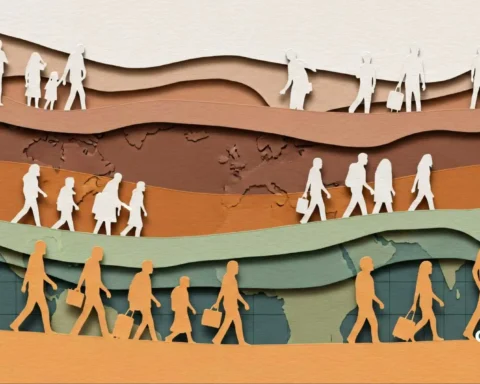Africa, historically labeled the “Dark Continent,” is forging a new trajectory toward development. With its rich natural resources and a large labor force, the continent possesses the significant potential to overcome colonialism’s legacies. Nonetheless, this optimistic outlook is jeopardized by entrenched structural issues, particularly regarding the management and effective use of its resources.
A critical issue facing Africa is its escalating public debt, which continues to burden economies across the region. Tackling this challenge necessitates thoroughly examining its underlying causes, consequences, and potential remedies. This article seeks to illuminate the complexities surrounding Africa’s public debt crisis and investigate pathways for sustainable economic recovery. As a global media organization, we are committed to conducting in-depth analyses and promoting informed dialogue that can help shape Africa’s financial future.
The probe begins.
Table of Contents
Understanding Public Debt in Africa: Trends, Challenges, and Prospects
Africa’s public debt reached USD 1.8 trillion in 2022, an 183% increase since 2010. Economic shocks from COVID-19, global inflation, and geopolitical tensions have raised concerns about its sustainability. This article explores its dynamics, implications, and potential solutions.
Top 10 African Countries with Highest Foreign Debts 2025
Historical Overview
The colonial era in Africa led to the depletion of natural resources and economic struggles. European powers exploited Africa’s mineral wealth, agricultural land, and forests for industrial revolutions. They prioritized the extraction of raw materials without reinvesting in African economies. Forced labor, land dispossession, and monoculture farming led to environmental degradation and economic dependency. Infrastructure projects were designed for European commercial interests, leaving many nations economically vulnerable upon independence.
Following African independence, nations faced challenges in restructuring their economies and political systems due to arbitrary colonial borders, civil conflicts, and economic dependency. Many relied heavily on former colonizers for trade and financial aid, leading to cycles of economic dependency. Cold War-era rivalries further destabilized the continent. Governments turned to external borrowing for development, resulting in rising public debt. Weak governance, corruption, and unfavorable trade terms exacerbated the financial crisis. Today, Africa seeks economic reforms and sustainable growth to reduce dependency on external debt.

Current State of Public Debt in Africa
The public debt landscape in Africa is characterized by rising debt levels, with the continent’s debt-to-GDP ratio rising from 31% in 2010 to 67% in 2023. This rise is attributed to the accumulation of new debts and stagnant economic growth rates. A significant portion of Africa’s public debt is external, accounting for nearly 60% of total debt by 2023. This reliance on foreign borrowing increases vulnerability to currency fluctuations and external economic conditions. Eight African countries are currently experiencing debt distress, with thirteen at risk.
Top 10 African countries with the highest external debt | Business Insider Africa
Main Features of Africa’s Long-Term Debt
African Debt – ONE Data & Analysis
The evolution of public debt in Africa over the past decade highlights its composition, trends, challenges, and implications for economic development. It emphasizes the importance of understanding these features for assessing the continent’s financial stability and growth prospects.
Features of Africa’s Long-Term Debt
High Levels of Debt – Africa’s public debt has risen to around USD 1.8 trillion as of 2022, driven by factors like the COVID-19 pandemic, rising inflation, and geopolitical tensions. The continent’s average debt-to-GDP ratio increased from 31% in 2010 to 67% in 2023.
External Debt Dominance – Africa’s long-term debt is primarily external, with 60% of total public debt owed to foreign creditors. This exposes the country to currency fluctuations and global economic conditions. The debt is concentrated among ten nations, accounting for 67% of Africa’s external debt.
Shift in Creditor Composition – Africa’s creditors have transitioned from traditional institutions like the World Bank and IMF to private lenders and non-Paris Club entities. As of 2023, over 43% of Africa’s external debt is owed to private creditors, with China emerging as a significant bilateral lender holding nearly USD 62 billion.
African Debt – ONE Data & Analysis
Long-Term Debt Focus – Africa’s borrowing has shifted towards long-term debt instruments, with the share of long-term debt in total public debt rising from 72% to 75% between 2008 and 2023, primarily due to financing infrastructure projects requiring stable funding over extended periods.
Rising Cost of Borrowing – The rise in borrowing costs for African countries, primarily due to global interest rates and increased investor risk perceptions, poses significant challenges for struggling countries with high debt servicing obligations.
Concentration of Maturities – Africa’s long-term debt is heavily concentrated between 2024 and 2028, with many nations issuing short-term Eurobonds. This has led to a peak in repayment obligations, heightening refinancing risks and raising the likelihood of sovereign defaults, as evidenced by recent cases.
Debt Sustainability Indicators – Africa’s public debt sustainability has worsened in recent years, with key indicators such as the debt-to-GDP and debt-to-exports ratios reaching critical levels. This trend signals that many countries are nearing thresholds that could lead to financial distress or default. The aggregated debt-to-GDP ratio surged between 2008 and 2020.
Impact on Development Goals – Rising public debt in Africa threatens development goals as governments divert a growing share of their budgets to debt servicing. This reduces funding for critical sectors like healthcare, education, and infrastructure, potentially slowing progress toward sustainable development.
African Debt – ONE Data & Analysis
African Debt – ONE Data & Analysis
Factors Contributing to Rising Public Debt
The COVID-19 pandemic significantly impacted African economies, disrupting trade, reducing revenues, and increasing health and social support expenditures. This led to higher borrowing and government stabilization efforts. The conflict in Ukraine and rising global interest rates have further complicated these issues, making it more expensive for African countries to service their debts and limiting access to new financing.
African nations are shifting from traditional bilateral creditors to private and non-traditional lenders, leading to increased borrowing and complex repayment structures as they rely more on international capital markets for infrastructure financing.
Factors leading to rising debt in Africa
High public debt in Africa is a complex issue influenced by various interrelated factors. Below are the primary reasons contributing to the rising levels of public debt across the continent:
Economic Vulnerability and Lack of Diversification – African economies rely heavily on commodity exports, which are subject to global price fluctuations. This makes it difficult to generate stable revenue, and manage fiscal deficits and service debts effectively. The lack of economic diversification exacerbates this vulnerability.
Global Economic Shocks – Africa has been severely impacted by global economic shocks, including the COVID-19 pandemic, which led to reduced revenues and increased healthcare and social support expenditures, and the ongoing Ukraine war, which caused rising food prices and supply chain disruptions, causing many countries to increase borrowing to cover budget shortfalls.-
Rising Interest Rates – Rising interest rates in developed economies have increased borrowing costs for African nations, making it more expensive to service existing debts and secure new financing. This higher average financing cost places additional pressure on already strained public budgets.
Structural Adjustment Programs (SAPs – Introduced by the IMF and World Bank in the 1980s and 1990s, structural adjustment programs (SAPs) have left a lasting mark on African economies. These programs often enforced austerity measures and social spending cuts, slowing economic growth and development. Their effects continue to shape Africa’s current debt landscape.
Increased Borrowing for Infrastructure Development – African countries increasingly rely on international capital markets to finance infrastructure projects. However, these investments often come with high costs and short repayment periods, leading to increased debt levels without guaranteed revenue generation. The reliance on Eurobonds also contributes to high-interest debt accumulation.
Changing Creditor Landscape – Africa’s shift from traditional bilateral creditors to private lenders has resulted in higher interest rates, with private creditors holding over 40% of the continent’s external debt in 2021. This has made it increasingly difficult for governments to manage debt sustainably.
Limited Domestic Resource Mobilization – African countries face challenges in mobilizing domestic resources due to weak tax systems and informal economies, which limit revenue generation. The global financial crisis has exacerbated this issue, causing countries to rely more on borrowing than on improving revenue collection.
Debt Servicing Pressures – With rising public debt, servicing costs have surged, consuming over 14% of government revenues in more than 20 African nations. This diverts funds from critical sectors like healthcare and education, deepening poverty and inequality.

Implications of High Public Debt
Public debt is increasing, impacting economic stability and growth by limiting government spending on critical sectors like health, education, and infrastructure. The risk of default has increased, with loans in default reaching a record USD 149.4 billion in 2022. This could destabilize regional economies and undermine investor confidence, reducing foreign direct investment inflows crucial for economic growth.
Reduced Fiscal Space – Rising public debt levels in 20 African nations consume over 14% of government revenues, diverting funds from essential services like healthcare and education, further entrenching poverty and inequality.
Increased Risk of Debt Distress – African countries face a heightened risk of debt distress, driven by high borrowing costs, currency depreciation, external shocks such as the COVID-19 pandemic, and geopolitical tensions. Nations like Zambia and Ghana have already experienced defaults, underscoring the fragile fiscal conditions and the potential for widespread defaults to trigger economic instability and erode investor confidence.
Crowding Out Private Investment – Rising government debt can crowd out private investment, as financial institutions holding large amounts of public debt have less capital to lend to businesses. This restricts growth, stifles innovation, and hampers economic development by limiting job creation and entrepreneurship opportunities.
Impact on Economic Growth – Research shows a nonlinear relationship between public debt and economic growth in Sub-Saharan Africa, with debt levels exceeding 78% to 85% of GDP negatively impacting economic performance. High debt burdens cause investor uncertainty, reduced consumer spending, and lower economic activity, hindering sustainable growth for long-term development.
Increased Income Inequality – Public debt initially aids development, but unchecked accumulation can worsen income inequality. Governments diverting funds from social programs to service debts may disproportionately affect vulnerable populations, widening the wealth gap and undermining social cohesion.
Implications of rising debt in Africa
Vulnerability to External Shocks – High public debt levels in African countries increase their vulnerability to external shocks like global economic downturns or commodity price fluctuations. Countries reliant on commodity exports face significant risks when prices drop, leading to revenue losses and exacerbated debt challenges, as highlighted by the COVID-19 pandemic.
Deterioration of Public Services – Governments’ prioritization of debt servicing over public spending has led to a decline in essential services like healthcare and education, particularly during the COVID-19 pandemic. This deterioration can have long-term impacts on human capital development and societal well-being.
Challenges in Debt Management – African governments face significant challenges in managing high public debt due to a lack of institutional capacity and technical expertise. This leads to inefficient borrowing practices and increased risks of mismanagement or corruption.
Strategies for Managing Public Debt
Countries with high debt levels may need to negotiate with creditors to extend repayment periods or reduce interest rates, implementing innovative restructuring solutions. Effective fiscal policies are essential for boosting revenue generation, controlling expenditures, strengthening tax systems, and improving public financial management. Diversifying financing sources, such as domestic capital markets or public-private partnerships, can enhance resilience against external shocks by reducing reliance on external borrowing.
Engaging with international financial institutions (IFIs) for technical assistance and financial support is crucial for countries with high debt levels. Offering affordable financing options can mitigate the negative effects of rising debts. Prioritizing investments in growth sectors like agriculture, technology, and renewable energy can improve debt sustainability, create jobs, and boost government revenues.

Recommendations for African Governments to Ease Out of Public Debt
Africa’s public debt crisis necessitates a comprehensive strategy emphasising sustainable economic growth, fiscal discipline, and responsible borrowing. Here are key recommendations for African governments:
Enhance Domestic Revenue Mobilization
Governments should enhance tax collection systems, reduce evasion, and formalize informal sectors for efficient taxation policies, including fair corporate taxation and reducing illicit financial flows.
Promote Economic Diversification
Africa’s heavy reliance on commodity exports poses economic risks, but investing in manufacturing, technology, and value-added industries can enhance stability and drive job creation.
Improve Debt Transparency and Management
Governments should implement transparent debt reporting mechanisms, strengthen debt management frameworks, and establish independent oversight bodies to prevent excessive borrowing and corruption.
Renegotiate Debt Terms and Seek Relief
African nations can enhance their bargaining power in global financial negotiations by engaging in diplomatic negotiations with creditors like China, the IMF, and the World Bank, thereby securing better repayment terms.
Attract Foreign Direct Investment (FDI) and Strengthen Public-Private Partnerships (PPPs)
Governments should foster economic growth by encouraging investment in infrastructure, energy, and technology through Public-Private Partnerships, promoting a business-friendly environment with clear policies.
Reduce Dependency on External Borrowing
Strengthening domestic financial markets, issuing government bonds, and promoting regional trade can offer alternative funding sources while promoting local investments and intra-African trade through the AfCFTA can reduce external credit reliance.
Control Government Expenditure and Eliminate Waste
Governments should adopt prudent fiscal policies, reduce unnecessary spending, eliminate corruption, and ensure efficient resource allocation, investing in productive sectors for economic stability.
Leverage Technology for Financial Inclusion
Governments should implement prudent fiscal policies, reduce unnecessary spending, eliminate corruption, and ensure efficient resource allocation, investing in productive sectors for economic stability.
By implementing these strategies, African governments can gradually ease their debt burdens while fostering sustainable economic development and financial independence.
Future Outlook
The public debt outlook in Africa is uncertain but could improve if proactive measures are taken. Projections suggest that Africa’s public debt will remain above pre-pandemic levels through 2025, with stabilization possible if robust economic growth and effective fiscal management strategies continue. The IMF forecasts a gradual decline in the continent’s debt-to-GDP ratio from 67% in 2023 to 63% by 2028. Changes in global economic conditions will significantly influence Africa’s debt dynamics, and easing monetary policies by major central banks could improve debt management.
Unlocking the Development Potential of Public Debt in Sub-Saharan Africa
Unlocking the Development Potential of Public Debt in Sub-Saharan Africa
Conclusion
African public debt is a major economic, social, and political issue causing financial distress, poverty, and inequality. It diverts resources from essential public services and exposes African economies to global financial shocks and political influence. Historical, structural, and governance issues exacerbate the crisis, including colonial exploitation, political instability, corruption, and mismanagement. African governments should adopt sustainable debt management strategies, regional cooperation, fairer trade agreements, and re-negotiate debt terms to address this.
We aim to spread this message to Africa’s citizens and governments. Comprehensive policies implemented judiciously are the cornerstone of any nation’s overall progress. Let’s await the enviable position Africa could be in a few decades.










